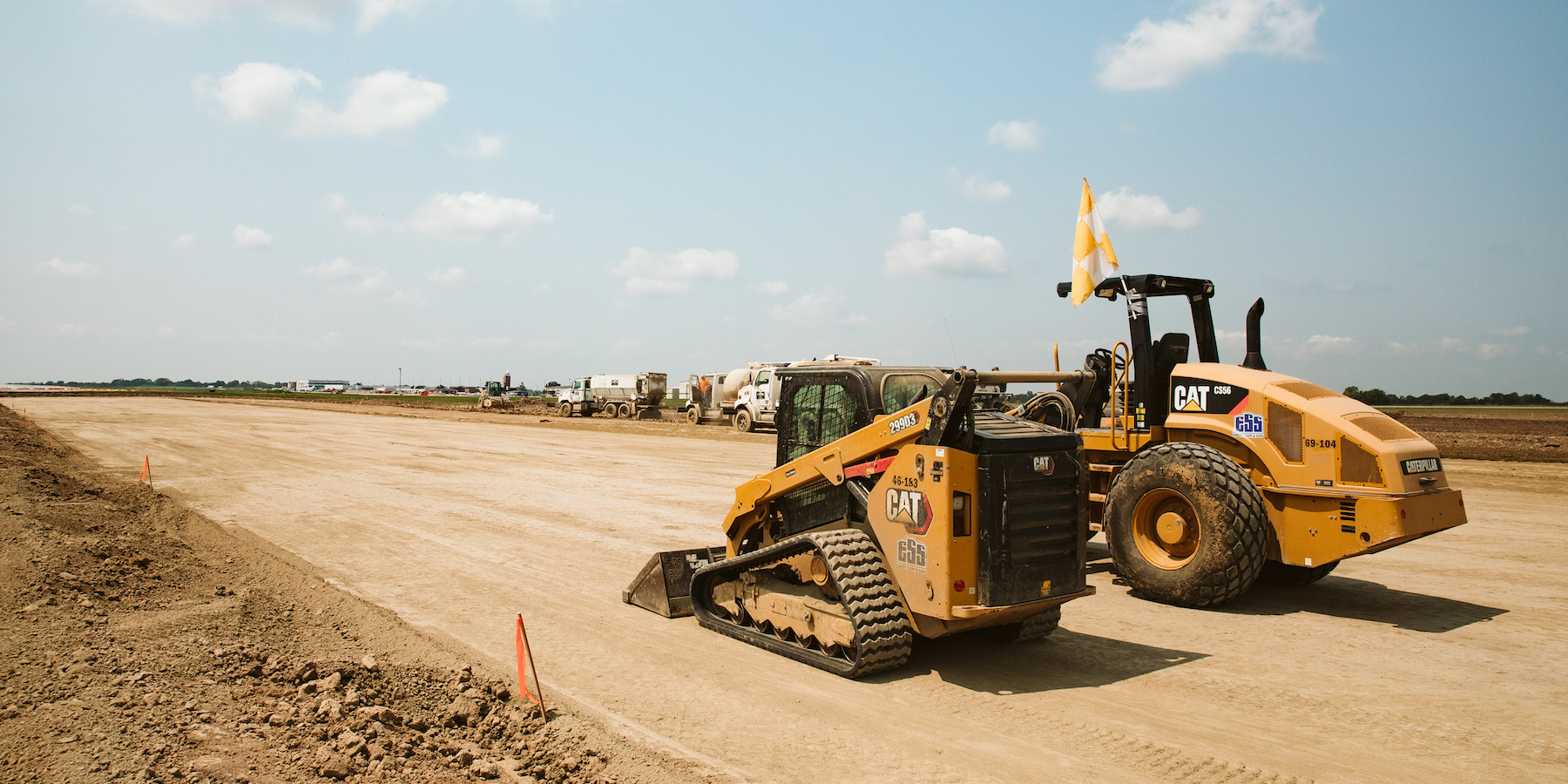Fast-Tracked Delivery
The City of Columbia, Missouri is very near and dear to our hearts here at Emery Sapp & Sons (ESS) as the home of our office headquarters. It’s also the place we were founded in 1972. Since then, ESS has earned quite a reputation for delivering quality infrastructure on fast-track aviation projects. So, when the City of Columbia needed a general contractor for the Columbia Airport Runway 2-20 Extension Project, ESS pursued the opportunity aggressively.
Project Manager Kyle Martin mentioned the importance of this job and why it was special to ESS and the Columbia community. “This project is important to us because it is close to home, and it will allow bigger aircrafts to come in and out of the Columbia Regional Airport. This will help expand the airport’s opportunities to gain new flights and provide more convenience to Columbia Regional Airport (COU) travelers. We’re proud to be a part of the future growth of Columbia.”
With a competitive bid and top-notch approach, ESS was awarded the project and immediately got to work. Like most aviation projects, this runway extension project required a very fast-track schedule. In fact, ESS was contracted to complete the project in just 240 calendar days. With only 8 months to construct this project, ESS crews got off to a fast start on April 26, 2021.

The total construction cost of the project will be approximately $8.7 Million. The scope of the project includes a complete reconstruction of the intersection of runway 2-20 and runway 13-31. In addition to a large volume of excavation and concrete paving, the project also includes the installation of an underdrain system, a full electrical package, retro reflective markers, pavement markings and seeding. Upon completion, the runway will consist of 1,100 feet of new extension.
ESS has also worked closely with subcontractor Meyer Electric to install a new NAVAID package on the north end of runway 2-20. NAVAID systems are critical to the safety and efficiency of flight operations at an airport. This includes features such as airfield lighting, signage, visual, and navigational aid.
To maximize efficiency and accelerate production, the project will be constructed in four phases; each phase marked by critical milestones and required closures:
- Phase 1 consisted of a 14-day closure of runway 2-20 for electrical modifications, pavement marking removals and displacing the threshold of runway 2-20.
- During Phase 2 runway 13-31 underwent a 60-day closure in order for crews to complete 31,000 square yards (SY) of concrete paving, 6,400 linear feet (LF) of underdrain and all new edge lighting for the new runway extension.
- Phase 3 was crucial to completing the runway extension within the 240 calendar-day time frame. There were no closures during this phase. This meant grading crews were challenged to complete all the runway extension earthwork in time for the subbase course to be placed. Kudos to our crews for having all the earth work complete and the site ready for pavement.
- Phase 4 will consist of grading out the safety area for the existing runway and adding all new LED edge lighting for the runway.
Strategic Approach
A fast-track runway project with this many closures meant ESS crews needed to find ways to accelerate their work while maintaining quality. The team made the decision early to utilize two things that would help them do just that.
The first key item utilized by the team was a CAT milling machine. This stellar piece of equipment helped our teams efficiently remove a significant amount of asphalt – 1,100 tons to be exact. Andy Baker, Assistant Vice President with our ESS Asphalt – Columbia team described how this machine helped maximize production and keep the runway extension on track.
“The milling machine removes the existing asphalt pavement to a specified depth quickly and more efficiently than traditional dog-out removal methods. This allowed the team to make rapid progress in the early phases. And this won’t be the only project to benefit from this milling machine. We will also be able to transform removals from this project into recycled asphalt pavement (RAP) material that can be used on future ESS projects. RAP is 100% recyclable and can be used back in new asphalt mixtures or used for materials onsite to reduce the amount of rock material needed to be brought into the site. Utilizing RAP in newly produced asphalt reduces the amount of virgin aggregates and oil needed because the RAP contributes these products to the new mixture.”

The second key item utilized by the team was a Jet Blast Deflector Fence. This reinforced fencing system is a safety device that is used in airports to absorb and redirect the blast from a large aircraft. Kyle Martin shared a few words on how this fencing system was crucial to staying on schedule.
“The Jet Blast Deflector Fence allowed us to continue working even while the airport was open. Since some of the work within this area has required night closures of the airport, utilizing this piece of equipment was crucial to keep the project on schedule.”

Key Figures
With the utilization of some schedule-compressing equipment, crews have already put up some impressive stats:
Grading & Excavation: 260,000 CY of embankment; 357,000 SY of topsoil placement
Concrete Paving: 33,990 SY of 12.5” PCCP
Underground Utilities: 6,400 LF of underdrain pipe installation
ESS crews continue to make great progress on this project. Construction is expected to be completed on time, by December 21, 2021. If you plan on flying into Columbia Regional Airport (COU) at the beginning of 2022, you can thank the following individuals for their hard work and leadership to ensure you have a smooth landing:
Project Superintendent – Brian Sapp
Paving Superintendent – Scott Smith
Paving Foreman – Josh Wisdom
Pipe Superintendent – Jordan Morris
Pipe Foreman – Zac Baker, Dylan Burke, Zach Edwards
Grading Foreman – Jimmy Bishop
Trimming Foreman – Chris Brumfield
Surveyor – Matt Buscher
Stringless Technician – Nathan Gall
Projects

